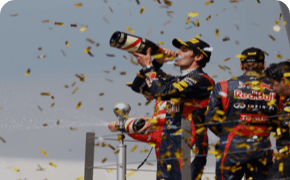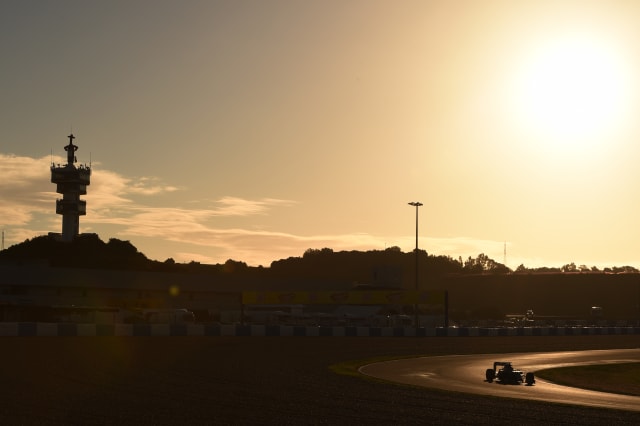1. Can we believe Ferrari’s pace?
A few months, as the old adage goes, can be a lifetime in Formula One racing. But even so, Ferrari’s turnaround from a winter of discontent to shining at Jerez came as something of a surprise.
Kimi Raikkonen and Sebastian Vettel set the fastest two times and topped three of the four days of running in the opening Spanish session, with the duo also offering glowing early appraisals of the new SF15-T.
So is the Prancing Horse galloping once more? As positive as Jerez was, a truer test will arrive this week at Barcelona - where the track and climate are more representative, and where Ferrari’s rivals will begin to ramp up their own preparations. These four days at the Catalan circuit could offer crucial clues as to just how high Ferrari can set their sights in 2015.
2. Will Mercedes and Williams show their hand?
While neither team troubled the top of the timesheets at Jerez, there were ominous signs that Mercedes and Williams - the two form teams at the tail-end of last year - are once again in good shape.
The Silver Arrows in particular looked impressive in the opening test. Concerned with mileage rather than performance, the team racked up an imposing 516 laps over four days - more than 100 better than any of their rivals managed. With that tally under their belt, many expect the team to start exploring outright pace in the second test - in much the same manner as they did in 2014, when they sprang to the top of the timesheets to finish an emphatic 1.6s clear of the opposition. Will they put down another marker in Barcelona - or have the rest of the field managed to make inroads into Mercedes’ advantage?
Williams occupy a similar position. Felipe Massa and Valtteri Bottas were seventh and eighth on the aggregate timesheet at Jerez as Williams kept a low profile. The car looked nimble out on track however, and the drivers remarked on the ‘step forward’ the FW37 represents. Barcelona will go some way to revealing just how big that step is…
3. Crunch time for McLaren and Honda?
While Jerez was far from disastrous for McLaren and Honda, the first public outing of the MP4-30 was frequently interrupted and ultimately limited to just 79 laps.
Even so, McLaren said they had still been able to meet their prime objectives, while Honda said further upgrades would be made before the second test. But where such issues could be tolerated at Jerez, Barcelona will be far more of an acid test. With just eight days of running before the season opener in Australia, there is a very clear sense that McLaren and Honda must get some serious mileage under their belt if they are to hit the ground running in Melbourne.
4. Are Red Bull playing catch up again?
It wasn’t quite déjà vu for Red Bull in Jerez, but there were definite shades of 2014 as a sequence of Renault power unit issues set back the team’s progress - a situation not helped when Daniil Kvyat had to spend almost the entirety of the second day running without a front wing after an early driver error.
Both parties can overcome the slow start - indeed they fought back remarkably, and from a situation far more severe, last year. But Jerez did add a degree of pressure for the remaining two tests at Barcelona. Encounter more problems, and both Red Bull and Renault could be playing catch up once more.
For their part, Renault have said the issues they encountered have been understood and fixed. But make no mistake: a lack of unhindered running in Barcelona will be a clear setback for a team looking to regain their championship crown.
5. Will Sauber continue to impress?
After a dismal 2014 campaign that yielded not a single point, Sauber caught the eye at the first test in Jerez with some headline grabbing times. However, heading to Barcelona the jury’s still out on the relative merits of the new C34, not least because the Swiss team set their best times on soft tyres when many others (excluding Ferrari) stuck to harder rubber.
There seems no doubt that Sauber have benefitted from a much-need step forward by Ferrari on the power unit front, and the new car certainly looks considerably more consistent than the C33, which looked wildly unpredictable at times. But is there more to come from the package? We should get that answer at Barcelona where the C34’s aerodynamics - a relative weak point on the C33 -will be given a much sterner test than in Jerez.
6. How much will Force India benefit by running their ’14 car?
Ever since Force India’s glamorous team launch in Mexico City in January, fans have been clamouring for a glimpse of the freshly-liveried VJM08, but the new car has yet to see the light of day – and it won’t be running in Barcelona.
Instead, the Silverstone-based squad have opted to attend the second Spanish session with last year’s car, with the hope that the new machine will finally be ready to run over the final four day test. Given Force India cited the fact that "learning opportunities would have been limited" as a reason not to run the VJM07 in Jerez, it will be interesting to see what programme they follow in Catalunya, especially as Mercedes’ inexperienced (but highly-regarded) reserve driver Pascal Wehrlein will be handling driving duties on two of the four days.
The young German is slated to drive in both of this year’s in-season tests for Vijay Mallya’s squad, so running the old car at Barcelona is extremely beneficial from that point of view, but otherwise you expect the team will concentrate primarily on tyre evaluation work. Such activity is always useful, though hardly ideal when every other team is racking up crucial development laps in their new machines.
7. Will we get our first glimpse of how much faster F1 racing will be in 2015?
The sweeping rule changes of 2014 mean that the current technology in Formula One racing is still relatively new, and that has led to gains being made across the board ahead of the forthcoming campaign. Teams have refined their bodywork and aerodynamics, while the efficiency and output of power units has come on leaps and bounds. The upshot? Lap times are likely to be a whole lot faster this year.
That was already proved at Jerez, where Kimi Raikkonen’s test-topping 1m 20.841s was in the region of 2.5 seconds quicker than last year’s corresponding benchmark. But Barcelona, as a far more representative circuit, will offer a far more accurate glimpse into just how much laptime has been gained over the winter. The last time F1 visited the Catalan circuit in pre-season was 2013, when Nico Rosberg set an outright best of 1m 20.130s. Based on what we saw at Jerez, that may not be totally out of reach…



















